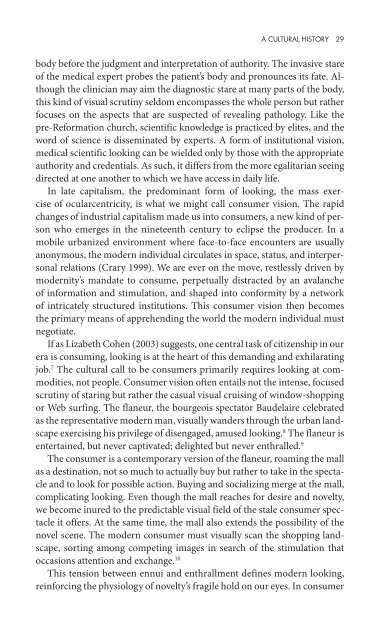Staring how we look sobre la mirada.pdf - artecolonial
Staring how we look sobre la mirada.pdf - artecolonial
Staring how we look sobre la mirada.pdf - artecolonial
You also want an ePaper? Increase the reach of your titles
YUMPU automatically turns print PDFs into web optimized ePapers that Google loves.
10 ABOUT STARING<br />
is the matter of appearance, of the ways <strong>we</strong> see each other and the ways <strong>we</strong><br />
are seen. It unsettles common understandings that staring is rudeness, voyeurism,<br />
or surveil<strong>la</strong>nce or that starers are perpetrators and starees victims.<br />
Instead, this vivisection <strong>la</strong>ys bare staring’s generative potential.<br />
The “<strong>we</strong>” of this book is a rhetorical convention to draw readers into an<br />
identification with the book’s point of view, with its contention that staring<br />
is a universal impulse. The “<strong>we</strong>” does not imply any exclusive group, but<br />
rather it recruits an ideal reader: the general, educated reader or academic<br />
who is curious about why <strong>we</strong> stare. William Ian Miller calls this convention<br />
the “invitational <strong>we</strong>,” which is “the voice of attempted sympathy and<br />
imagination.” 12 This rhetorical strategy is an effort to avoid the f<strong>la</strong>ttening<br />
pronominal dichotomy of “<strong>we</strong>” and “they” that divides starers from starees.<br />
The use of “<strong>we</strong>” yokes starers and starees in a mutually defining process<br />
that helps reveal <strong>how</strong> social re<strong>la</strong>tions create identities. By framing staring as<br />
a psychologically fraught and socially charged encounter, the book addresses<br />
<strong>how</strong> identity emerges through interactive processes. In this way, <strong>Staring</strong> expands<br />
the broad critical discussion about visuality in modernity through its<br />
focus on disability identity formation. In other words, it s<strong>how</strong>s <strong>how</strong> staring<br />
works, what it does, and <strong>how</strong> it makes us who <strong>we</strong> are. This anatomy strives<br />
to reveal connections among our own staring practices, interpersonal re<strong>la</strong>tions,<br />
and the meanings <strong>we</strong> give to human variations.<br />
To dissect staring, the book approaches staring from a distinctly social<br />
model, using several analytical instruments: the social sciences of visual<br />
communication, interactionism, cognitive and social psychology; the history<br />
of visuality and curiosity; and most of all, the humanistic disciplines of<br />
philosophy, disability and feminist theories, ritual and performance studies,<br />
and literary criticism. It uses these tools on an eclectic collection of “scenes<br />
of staring” that serve as case studies. These scenes take the form of narrative<br />
accounts, artistic representations, photographs, films, and performances. In<br />
all, <strong>Staring</strong> : How We Look is stalwartly humanistic in its approach. Its perspective<br />
is more that of the literary critic and philosopher than the historian<br />
or social scientist. To bring forward the generative rather than the oppressive<br />
aspects of staring, it leans more toward Erving Goffman than Michel<br />
Foucault, more toward Charles Taylor and Martin Buber than Jean-Paul Sartre,<br />
more toward D. W. Winnicott than Jacques Lacan.<br />
Because most studies and analyses of staring focus on starers, bringing<br />
forward the roles of starees is crucial to presenting a full account of staring.<br />
Human starees, rather than car wrecks or sublime spectacles, epitomize<br />
the staring encounter and are the center of this book. To get at what starees<br />
do and <strong>how</strong> they understand these intense interpersonal visual exchanges,<br />
this anatomy of staring draws from self presentations, visual representations,<br />
and published accounts by and of starees as <strong>we</strong>ll as interviews with


